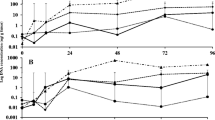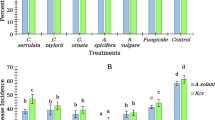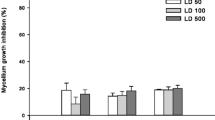Abstract
The phytoelicitor and phytostimulatory properties of alkaline extracts of two tropical seaweeds, Sargassum vulgare C. Agardh and Acanthophora spicifera (M.Vahl) Børgesen, collected from the coasts of Trinidad were investigated in tomato and sweet pepper crops. Foliar applications of seaweed extracts (SWE), at 0.5% concentration, resulted in substantial reductions in disease severity by the pathogens, Xanthomonas campestris pv. vesicatoria and Alternaria solani under greenhouse and field conditions. The effects of SWE on disease suppression were significantly improved when integrated with a minimum dose of fungicide. SWE-treated plants also showed enhanced plant growth and yield parameters. Investigations into the modes of action for disease suppressive effects revealed that SWE-treated plants had sustainably augmented defense enzyme activities and phenolic levels. The activation of defense pathways was validated by confirming the upregulation of marker gene transcripts (PR-1a, PinII, and ETR-1) which are involved in defense signalling pathways. The SWE-treated plants also showed significant upregulation of genes involved in auxin (IAA), gibberellin (Ga2Ox), and cytokinin (IPT) biosynthesis. Multiple applications of SWE in crop plants have minimized the need for chemical fungicide sprays. The current study demonstrates the applicability of tropical SWE for use in vegetable plants for achieving environmental-friendly and sustainable crop production.






Similar content being viewed by others
Data availability
Available with no restrictions.
References
Abdel-Mawgoud AMR, Tantaway AS, Hafez MM, Habib HAM (2010) Seaweed extract improves growth, yield and quality of different watermelon hybrids. Res J Agric Biol Sci 6:161–168
Adhikari P, Oh Y, Panthee DR (2017) Current status of early blight resistance in tomato: an update. Int J Mol Sci 18. https://doi.org/10.3390/ijms18102019
Ali N, Farrell A, Ramsubhag A, Jayaraj J (2016a) The effect of Ascophyllum nodosum extract on the growth, yield and fruit quality of tomato grown under tropical conditions. J Appl Phycol 28:1353–1362
Ali N, Ramkissoon A, Ramsubhag A, Jayaraj J (2016b) Ascophyllum extract application causes reduction of disease levels in field tomatoes grown in a tropical environment. Crop Prot 83:67–75
Ali O, Ramsubhag A, Jayaraj J (2018) Ascophyllum nodosum (Linnaeus) Le Jolis seaweed extract improves seed germination in tomato and sweet pepper under NaCl-induced salt stress. Tropical Agric 95:141–148
Ali O, Ramsubhag A, Jayaraj J (2019) Biostimulatory activities of Ascophyllum nodosum extract in tomato and sweet pepper crops in a tropical environment. PLoS One 14:e0216710
Arioli T, Mattner SW, Winberg PC (2015) Applications of seaweed extracts in Australian agriculture: past, present and future. J Appl Phycol 27:2007–2015
Blunden G, Jenkins T, Liu YW (1996) Enhanced leaf chlorophyll levels in plants treated with seaweed extract. J Appl Phycol 3:13–19
Borad V, Sriram S (2008) Pathogenesis-related proteins for the plant protection. Asian J Exp Sci 22:189–196
Butcher DJ (2000) Trace determination of pesticides and their degradation products in water. Microchem J 65:97–98
Calvo P, Nelson L, Kloepper JW (2014) Agricultural uses of plant biostimulants. Plant Soil 23:1113–1357
Chevolot L, Mulloy B, Ratiskol J, Foucault A, Colliec-Jouault S (2001) A disaccharide repeat unit is the major structure in fucoidans from two species of brown algae. Carbohydr Res 330:529–535
Crouch IJ, van Staden J (1993) Evidence for the presence of plant growth regulators in commercial seaweed products. Plant Growth Regul 6:345–388
Duncan EJ, Lee-Lum LM (2006) A checklist of the marine macroalgae of the Republic of Trinidad and Tobago. Caribb Mar Stud 7:1–96
El Modafar C, Elgadda M, El Boutachfaiti R, Abouraicha E, Zehhar N, Petit E, El Alaoui-Talibi Z, Courtois B, Courtois J (2012) Induction of natural defence accompanied by salicylic acid-dependant systemic acquired resistance in tomato seedlings in response to bioelicitors isolated from green algae. Scient Hort 138:55–63
Ertani, Schiavon M, Nardi S (2017) Transcriptome-wide identification of differentially expressed genes in Solanum lycopersicon L. in response to an alfalfa-protein hydrolysate using microarrays. Frontiers in Plant Science 8:1159
Esa FA, Harith MN, Hassan R (2012) Preliminary morphological study on seaweed Acanthophora spp. of Satang Island. In: Aquatic science colloquium: experience sharing in aquatic science research II, Talang-Satang National Park, Santubong. https://doi.org/10.13140/2.1.1527.3603
Featonby-Smith BC, Van Staden J (1983) The effect of seaweed concentrates on the growth of tomato plants in nematode-infested soil. Sci Hortic (Amsterdam) 3:13–19
Fornes F, Sánchez-Perales M, Guardiola JL (2002) Effect of a seaweed extract on the productivity of ‘de Nules’ clementine mandarin and Navelina orange. Bot Mar 43:345–354
Guindon S, Dufayard JF, Lefort V, Anisimova M, Hordijk W, Gascuel O (2010) New algorithms and methods to estimate maximum-likelihood phylogenies: assessing the performance of PhyML 3.0. Systematic Biol
Hall TA (1999) BIOEDIT: a user-friendly biological sequence alignment editor and analysis program for Windows 95/98/ NT. Nucleic Acids Symp Ser 41:95–98
Hammerschmidt R, Nuckles EM, Kuć J (1982) Association of enhanced peroxidase activity with induced systemic resistance of cucumber to Colletotrichum lagenarium. Physiol Plant Pathol 20:73–76
Hernández-Herrera RM, Virgen-Calleros G, Ruiz-López M, Zañudo-Hernández J, Délano-Frier JP, Sánchez-Hernández C (2014) Extracts from green and brown seaweeds protect tomato (Solanum lycopersicum) against the necrotrophic fungus Alternaria solani. J Appl Phycol 26:1607–1614
Jayaraj J, Ali N (2015) Use of seaweed extracts for disease management of vegetable crops. In: Sangeetha S, Kurucheve V, Jayaraj J (eds) Sustainable crop disease management using natural products. CABI, Wallingford, pp 160–183
Jayaraj J, Wan A, Rahman M, Punja ZK (2008) Seaweed extract reduces foliar fungal diseases on carrot. Crop Prot 44:345–366
Jayaraj J, Norrie J, Punja ZK (2011) Commercial extract from the brown seaweed Ascophyllum nodosum reduces fungal diseases in greenhouse cucumber. J Appl Phycol 15:145–155
Jia C, Zhang L, Liu L, Wang J, Li C, Wang Q (2013) Multiple phytohormone signalling pathways modulate susceptibility of tomato plants to Alternaria alternata f. sp. lycopersici. J Exp Bot 64:637–650
Khan W, Rayirath UP, Subramanian S, Jithesh MN, Rayorath P, Hodges DM, Critchley AT, Craigie JS, Norrie J, Prithiviraj B (2009) Seaweed extracts as biostimulants of plant growth and development. J Plant Growth Regul 45:112–134
Khopade M (2015) A preliminary study on the effects of ozone on induction of resistance in Cicer arietinum and Trigonella foenum against acute ozone exposure. IOSR J Biotech Biochem 1:6–14
Klarzynski O, Plesse B, Joubert J-M, Yvin J-C, Kopp M, Kloareg B, Fritig B (2000) Linear β-1,3 glucans are elicitors of defense responses in tobacco. Plant Physiol 124:1027–1038
Klarzynski O, Descamps V, Plesse B, Yvin JC, Kloareg B, Fritig B (2003) Sulfated fucan oligosaccharides elicit defense responses in tobacco and local and systemic resistance against tobacco mosaic virus. Molec Plant-Microbe Interact 16:115–122
Kunkel BN, Brooks DM (2002) Cross talk between signaling pathways in pathogen defense. Curr Opin Plant Biol 34:354–366
Li Y, Mattson NS (2015) Effects of seaweed extract application rate and method on post-production life of petunia and tomato transplants. HortTechnology 25:505–510
Mabeau S, Kloareg B (1987) Isolation and analysis of the cell walls of brown algae: Fucus spiralis, F. ceranoides, F. vesiculosus, F. serratus, Bifurcaria bifurcata and Laminaria digitata. J Exp Bot 38:1573–1580
Mahuku GS (2004) A simple extraction method suitable for PCR-based analysis of plant, fungal, and bacterial DNA. Plant Mol Biol Rep 22:71–81
Malathi S, Mohan S (2013) Induction of defense-related enzymes in onion by combined application of fungal and bacterial biocontrol agents against Fusarium oxysporum f. sp. cepae. Arch Phytopathol Plant Prot 46:243–252
Mattio L, Payri CE, Stiger-Pouvreau V (2008) Taxonomic revision of Sargassum (Fucales, Phaeophyceae) from French Polynesia based on morphological and molecular analyses. J Phycol 44:1541–1555
McNeil SD, Nuccio ML, Hanson AD (1999) Betaines and related osmoprotectants. Targets for metabolic engineering of stress resistance. Plant Physiol 67:45–56
Mercier L, Lafitte C, Borderies G, Briand X, Esquerré-Tugayé MT, Fournier J (2001) The algal polysaccharide carrageenans can act as an elicitor of plant defence. New Phytol 6:66–87
Nazeem PA, Achuthan CR, Babu TD, Parab GV, Girija D, Keshavachandran R, Samiyappan R (2008) Expression of pathogenesis related proteins in black pepper (Piper nigrum L.) in relation to Phytophthora foot rot disease. J Trop Ag 46:45–51
O’Doherty DC, Sherwood AR (2007) Genetic population structure of the Hawaiian alien invasive seaweed Acanthophora spicifera (Rhodophyta) as revealed by DNA sequencing and ISSR analyses 1. Pacific Sci 61:223–233
Perilli S, Moubayidin L, Sabatini S (2010) The molecular basis of cytokinin function. Curr Opin Plant Biol 34:123–143
Prasad K, Das AK, Oza MD, Brahmbhatt H, Siddhanta AK, Meena R, Eswaran K, Rajyaguru MR, Ghosh PK (2010) Detection and quantification of some plant growth regulators in a seaweed-based foliar spray employing a mass spectrometric technique sans chromatographic separation. J Agri Food Chem 43:165–176
Ramirez-Estrada K, Vidal-Limon H, Hidalgo D, Moyano E, Golenioswki M, Cusidó RM, Palazon J (2016) Elicitation, an effective strategy for the biotechnological production of bioactive high-added value compounds in plant cell factories. Molecules. 21:182
Ramkissoon A, Ramsubhag A, Jayaraj J (2017) Phytoelicitor activity of three Caribbean seaweed species on suppression of pathogenic infections in tomato plants. J Appl Phycol 34:123–129
Růzǐčka K, Šimášková M, Duclercq J, Petrášek J, Zažímalová E, Simon S, Friml J, Van Montagu MCE, Benková E (2009) Cytokinin regulates root meristem activity via modulation of the polar auxin transport. Proc Natl Acad Sci U S A 106:4284–4289
Sangha JS, Khan W, Ji X, Zhang J, Mills AAS, Critchley AT, Prithiviraj B (2011) Carrageenans, sulphated polysaccharides of red seaweeds, differentially affect Arabidopsis thaliana resistance to Trichoplusia ni (Cabbage Looper). PLoS One 6:123–133
Sharma HSS, Fleming C, Selby C, Rao JR, Martin T (2014) Plant biostimulants: a review on the processing of macroalgae and use of extracts for crop management to reduce abiotic and biotic stresses. J Appl Phycol 26:465–490
Shukla PS, Mantin EG, Adil M, Bajpai S, Critchley AT, Prithiviraj B (2019) Ascophyllum nodosum-based biostimulants: sustainable applications in agriculture for the stimulation of plant growth, stress tolerance, and disease management. Front Plant Sci 10:655
Stadnik MJ, Freitas MBD (2014) Algal polysaccharides as source of plant resistance inducers. Tropical Plant Pathol 39:111–118
Stirk WA, Bálint P, Tarkowská D, Novák O, Strnad M, Ördög V, van Staden J (2013) Hormone profiles in microalgae: gibberellins and brassinosteroids. Plant Physiol Biochem 70:348–353
Stöver BC, Müller KF (2010) TreeGraph 2: combining and visualizing evidence from different phylogenetic analyses. BMC Bioinformatics 11:7
Ugarte RA, Sharp G, Moore B (2006) Changes in the brown seaweed Ascophyllum nodosum (L.) Le Jol. plant morphology and biomass produced by cutter rake harvests in southern New Brunswick, Canada. J Appl Phycol 12:34–65
Van Oosten MJ, Pepe O, De Pascale S, Silletti S, Maggio A (2017) The role of biostimulants and bioeffectors as alleviators of abiotic stress in crop plants. Chem Biol Technol Agric 4:5
Vera J, Castro J, Gonzalez A, Moenne A (2011) Seaweed polysaccharides and derived oligosaccharides stimulate defense responses and protection against pathogens in plants. Mar Drugs 9:2514–2525
Wally OSD, Critchley AT, Hiltz D, Craigie JS, Han X, Zaharia LI, Abrams SR, Prithiviraj B (2013) Regulation of phytohormone biosynthesis and accumulation in arabidopsis following treatment with commercial extract from the marine macroalga Ascophyllum nodosum. J Plant Growth Regul 32:324–339
Yakhin OI, Lubyanov AA, Yakhin IA, Brown PH (2017) Biostimulants in plant science: a global perspective. Front Plant Sci 54:23–27
Žižková E, Dobrev PI, Muhovski Y, Hošek P, Hoyerová K, Haisel D, Procházková D, Lutts S, Motyka V, Hichri I (2015) Tomato (Solanum Lycopersicum L.) SlIPT3 and SlIPT4 isopentenyltransferases mediate salt stress response in tomato. BMC Plant Biol 15:85
Acknowledgments
The funding support provided by the UWI-RDI-IPOC grant for conducting the field experiments is gratefully acknowledged.
Funding
The funding support was provided by the UWI-RDI-IPOC grant.
Author information
Authors and Affiliations
Contributions
Omar Ali: experimentation, methodology, data collection, curation and analysis, writing the manuscript-original draft
Adesh Ramsubhag: data analysis, methodology, supervision, review and editing of the manuscript
Jayaraj Jayaraman: conceptualization, funding acquisition, investigation, methodology, project administration, resource provision, supervision, review and editing of the manuscript
Corresponding author
Ethics declarations
Conflict of interest
The authors declare no competing interests.
Consent for publication
All authors give consent for publication
Additional information
Publisher’s note
Springer Nature remains neutral with regard to jurisdictional claims in published maps and institutional affiliations.
Electronic supplementary material
ESM 1
(DOCX 193 kb)
Rights and permissions
About this article
Cite this article
Ali, O., Ramsubhag, A. & Jayaraman, J. Phytoelicitor activity of Sargassum vulgare and Acanthophora spicifera extracts and their prospects for use in vegetable crops for sustainable crop production. J Appl Phycol 33, 639–651 (2021). https://doi.org/10.1007/s10811-020-02309-8
Received:
Revised:
Accepted:
Published:
Issue Date:
DOI: https://doi.org/10.1007/s10811-020-02309-8




